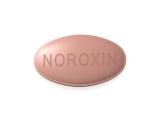- Amoxil
- Augmentin
- Bactrim
- Cipro
- Doxycycline
- Flagyl
- Zithromax
- Erythromycin
- Cenmox
- Amoxicillin
- Amoxil
- Ampicillin
- Augmentin
- Azithromycin
- Bactrim
- Biaxin
- Cefadroxil
- Ceftin
- Cefuroxime
- Cenmox
- Cephalexin
- Chloromycetin
- Cipro
- Ciprodex
- Ciprofloxacin
- Ciprofloxacin + Dexamethasone
- Cleocin
- Doxycycline
- Duricef
- Erythromycin
- Flagyl
- Floxin
- Ilosone
- Keflex
- Keftab
- Lamisil
- Macrobid
- Metronidazole
- Minocin
- Minomycin
- Myambutol
- Norfloxacin
- Noroxin
- Omnicef
- Sumycin
- Suprax
- Terbinafine
- Tinidazole
- Trecator-SC
- Trimethoprim
- Trimox
- Vantin
- Zithromax
- Zyvox

Generic Noroxin ( Norfloxacin )






Common Uses
Noroxin is a quinolone antibiotic commonly prescribed for infections of the urinary tract such as pyelonephritis, cystitis, and urethritis. It is also effective in treating infections of the genital organs including prostatitis, cervicitis, and endometritis, as well as gastrointestinal infections like salmonellosis and shigellosis. Additionally, Noroxin can be used for uncomplicated gonorrhea. It works by inhibiting DNA gyrase, an enzyme crucial for bacterial DNA replication, leading to bacterial cell death. This medication is effective against a range of bacteria including Staphylococcus species (such as Staphylococcus aureus), Neisseria, E. coli, Klebsiella, Proteus, Salmonella, Enterobacter, Shigella, Mycobacterium tuberculosis, Haemophilus influenzae, Chlamydia, Mycoplasma, and others. The drug remains active for approximately 12 hours.
Dosage and Directions
For urinary tract infections, the typical dose is 400 mg of Noroxin taken twice daily for 7 to 10 days. Uncomplicated cystitis treatment usually lasts 3 to 7 days, while recurrent or chronic urinary tract infections may require treatment for up to 12 weeks. Prostatitis is generally treated with a daily dose of 800 mg divided into two doses over four weeks. For gonorrhea, a single 800 mg dose is recommended. The maximum daily dose should not exceed 800 mg.
Take Noroxin with a full glass of water either two hours after eating or one hour before a meal. It is important to drink plenty of fluids during treatment to prevent the formation of crystals in the urine. Elderly patients and those with kidney issues may require dose adjustments or monitoring of kidney function. Always follow your doctor's instructions and do not begin or discontinue treatment without consulting your healthcare provider.
Precautions
- Regular monitoring of kidney function is advised for elderly patients and those with renal impairment.
- This medication can cause sensitivity to sunlight; avoid prolonged sun exposure during treatment.
- Limit alcohol consumption as it can intensify side effects such as dizziness and drowsiness, which may impair your ability to drive or operate machinery.
Contraindications
- Hypersensitivity to Noroxin or related quinolones
- Pregnant or breastfeeding women
- Children under 18 years of age
- Individuals with glucose-6-phosphate dehydrogenase deficiency
- Caution is needed in patients with cerebral arteriosclerosis, cerebrovascular disease, epilepsy, myasthenia gravis, and liver or kidney failure
Possible Side Effects
Common side effects include weakness, headache, dizziness, drowsiness, nausea, and stomach discomfort. Serious but rare reactions can involve tremors, seizures, mental or mood changes, vision or hearing disturbances, sore throat with fever, jaundice, fainting, abnormal heart rhythms, bleeding or bruising easily, numbness or tingling sensations, and tendon or muscle damage. If you experience joint or tendon pain, stop physical activity and seek immediate medical advice.
Persistent diarrhea, abdominal pain, or blood/mucus in stool after treatment could indicate pseudomembranous colitis; avoid anti-diarrheal and narcotic pain medications and notify your doctor promptly.
Long-term or repeated use may result in oral thrush or vaginal yeast infections, noticeable by white patches in the mouth or changes in vaginal discharge. Report any allergic reactions such as severe dizziness, rash, itching, swelling, or breathing difficulties to your doctor immediately.
Drug Interactions
- Theophylline dosage should be lowered when taken with Noroxin.
- Noroxin can increase blood levels of indirect anticoagulants and cyclosporine.
- Its effectiveness may be reduced by nitrofurans.
- Antacids containing aluminum or magnesium, iron or zinc supplements, and sucralfate should be spaced at least four hours apart from Noroxin.
- Drugs that lower the epileptic threshold may increase seizure risk when combined with Noroxin.
- Concomitant use with blood pressure or heart rhythm medications may cause dangerous changes in blood pressure or heart rate.
Always inform your healthcare provider about all medications, supplements, and herbal products you are using.
Missed Dose
If you miss a dose, take it as soon as possible unless it is almost time for your next dose. Do not double doses to compensate for a missed one; simply continue your regular dosing schedule.
Overdose
Symptoms of overdose may include dizziness, nausea, vomiting, drowsiness, cold sweating, and facial puffiness without significant changes in blood circulation. Seek medical attention if overdose is suspected.
Storage
Keep Noroxin stored at room temperature in a tightly closed container, away from moisture and humidity.
Disclaimer
This information is intended to provide a general overview of the medication and is not a substitute for professional medical advice. It does not cover all possible directions, drug interactions, or precautions. Always consult your healthcare provider for guidance tailored to your specific health needs. We are not responsible for any harm resulting from use of this information or self-treatment.



| Shipping method | Delivery time | Price | |
 Airmail service Delivery Airmail service Delivery |
14-21 days | 10$ | Tracking# available in 4 days |
 Trackable service Delivery Trackable service Delivery |
9-14 days | 30$ | Tracking# available in 2 days |
- Shipping worldwide
- Confidentiality and anonymity guarantee
- Safe and secure
- Discrete looking packages
- Dispatch orders within 24 hours
- 100% success delivery


